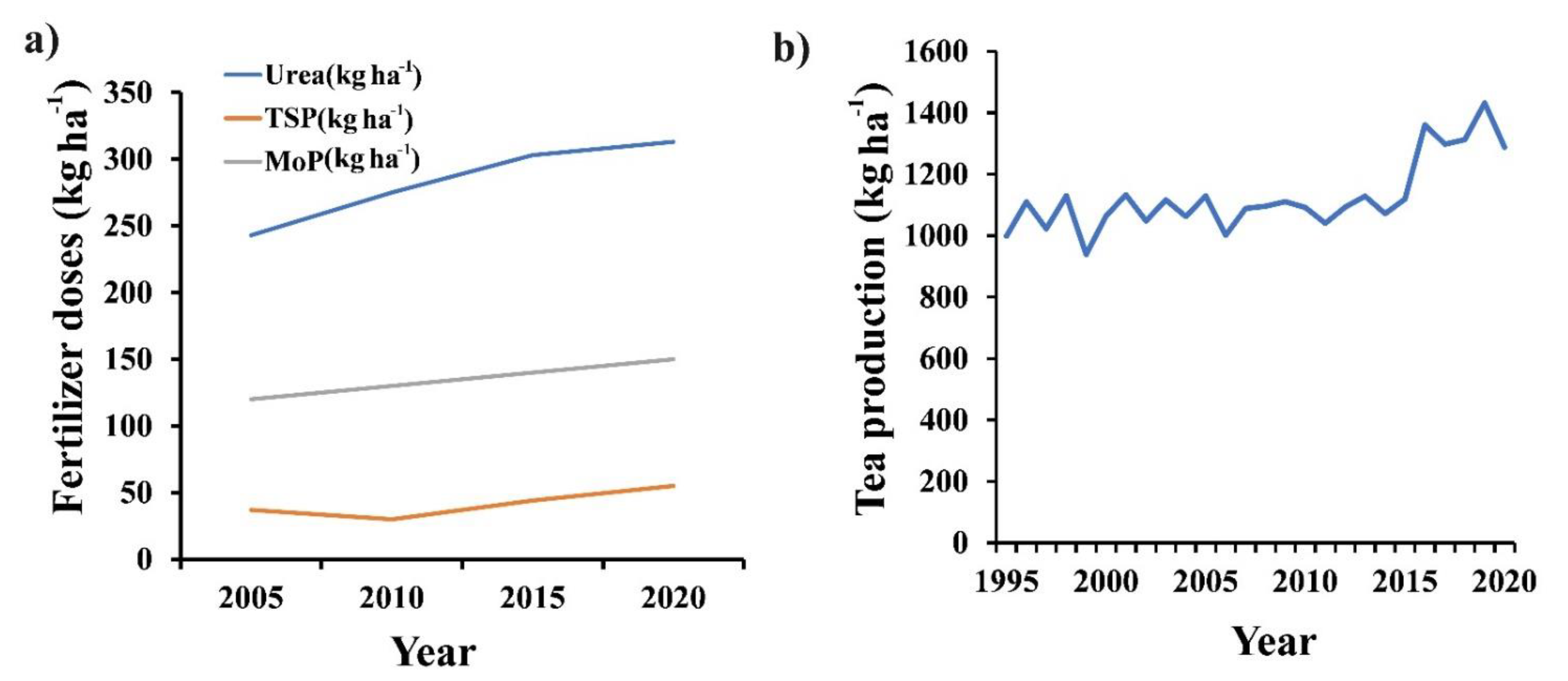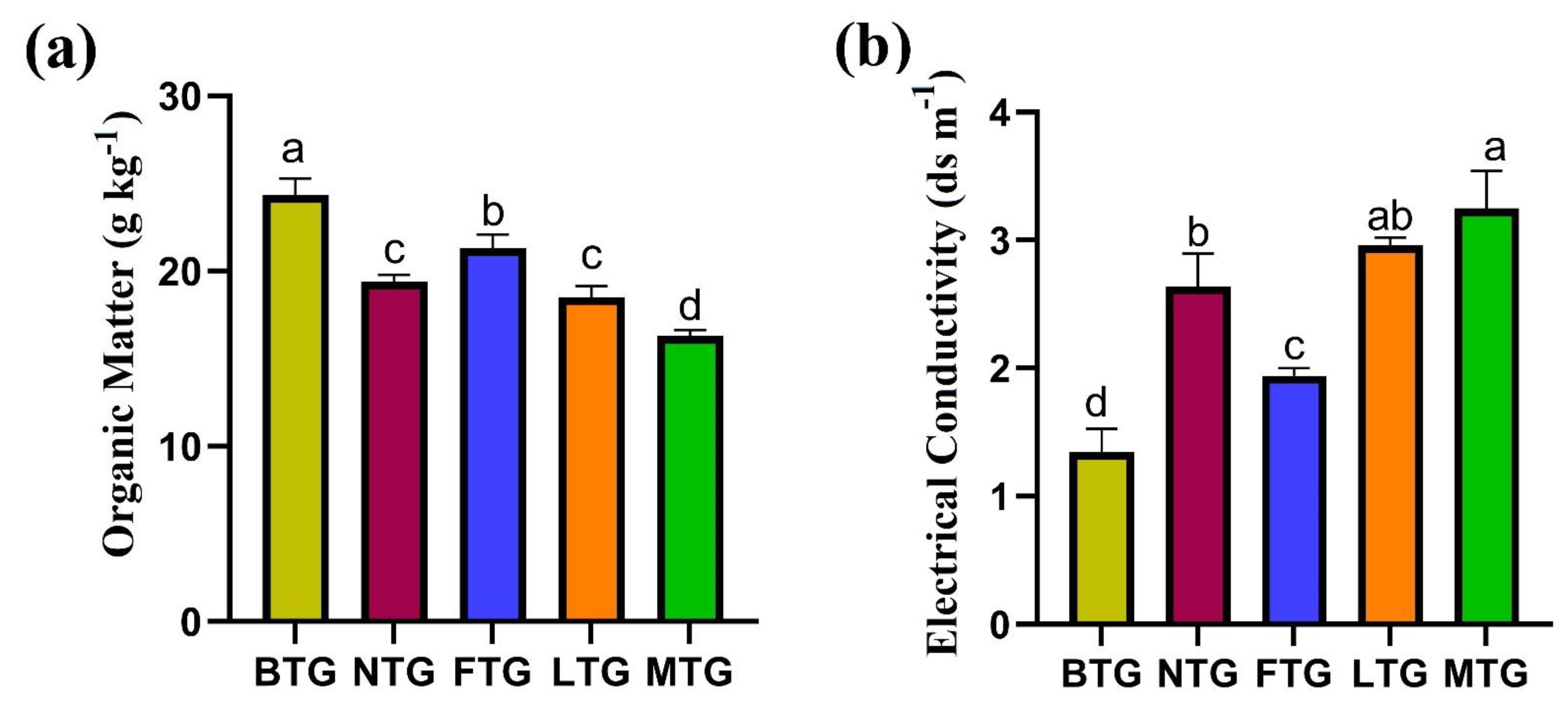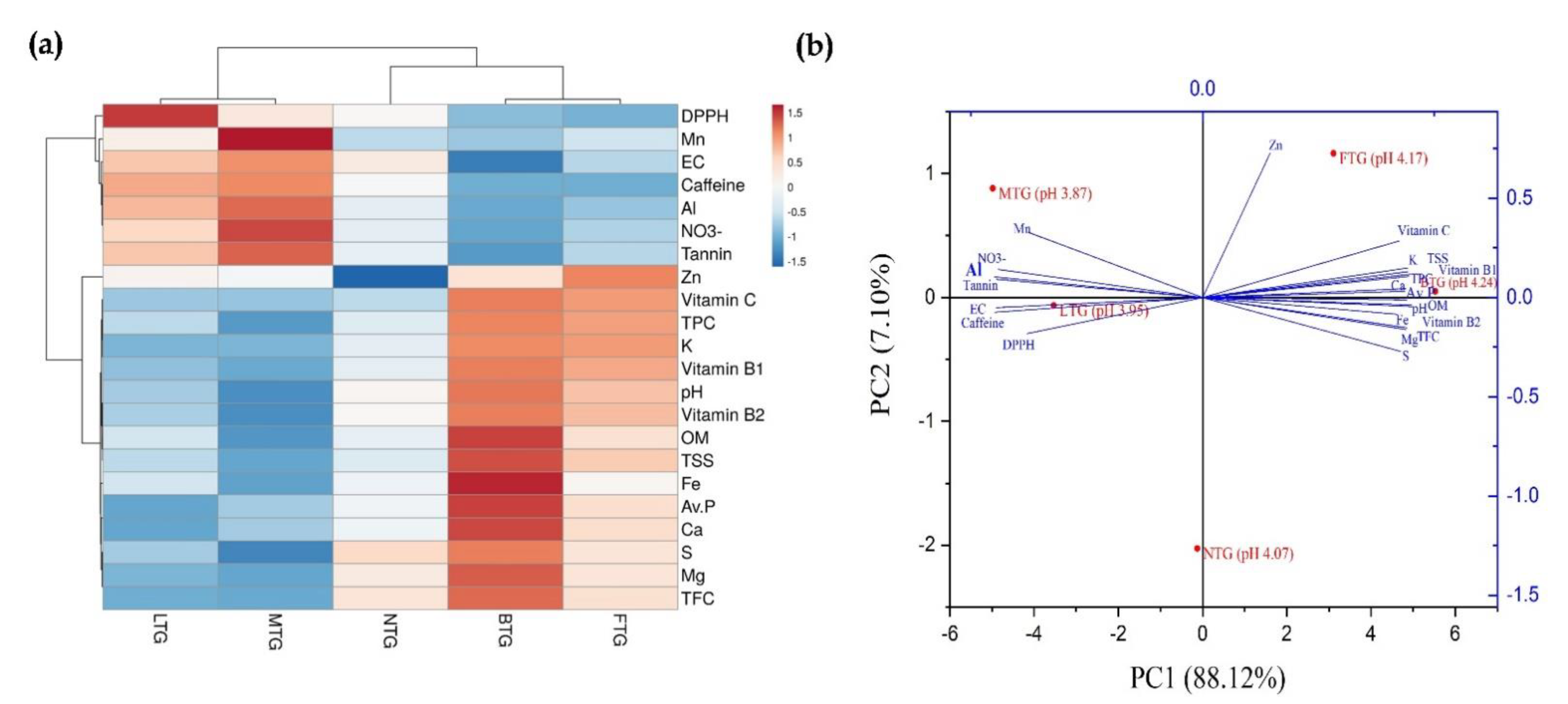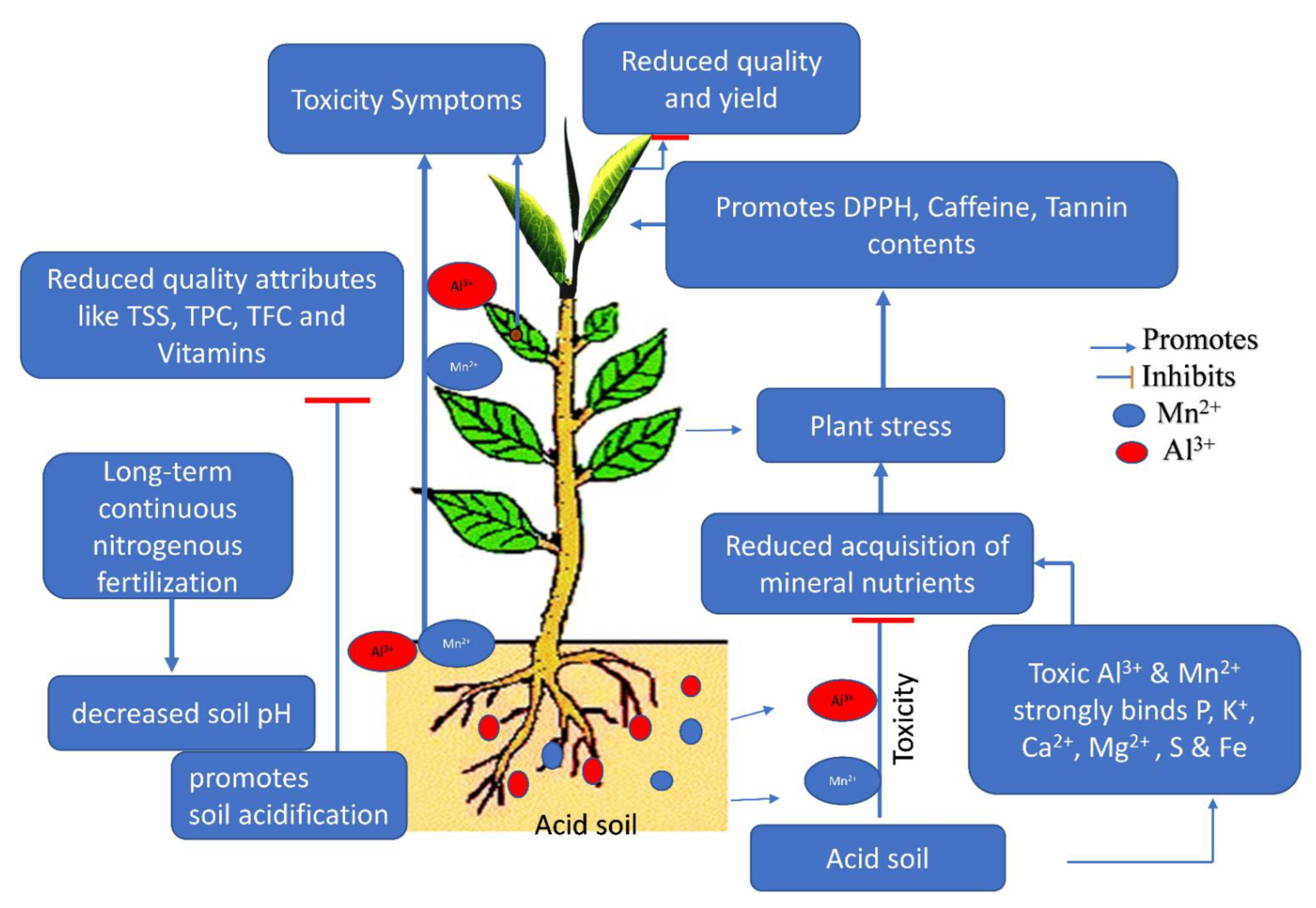Long-Term Traditional Fertilization Alters Tea Garden Soil Properties and Tea Leaf Quality in Bangladesh
Abstract
:1. Introduction
2. Materials and Methods
2.1. Sampling Area
2.2. Collection, Preparation, and Storage of Soil Samples
2.3. Collection and Analysis of Tea Leaves
2.4. Analysis of Soil Chemical Properties
2.5. Biochemical Assay of Tea Leaves
2.6. Detection of Nutritional Properties of Tea Leaves
2.7. Statistical Analysis
3. Results
3.1. Effect of Conventional Fertilization on Tea Leaves Production
3.2. Effect of Conventional Fertilization on Soil Nutritional Properties
3.3. Effect of Conventional Fertilization on Biochemical and Nutritional Qualities of Tea Leaves
3.4. Evaluation of Chemical Properties of Soils and Biochemical and Nutritional Qualities of Tea Leaves in Five Gardens through Heatmap and PCA Methods
4. Discussion
5. Conclusions
Supplementary Materials
Author Contributions
Funding
Institutional Review Board Statement
Informed Consent Statement
Data Availability Statement
Acknowledgments
Conflicts of Interest
References
- Hajiboland, R. Environmental and nutritional requirements for tea cultivation. Folia Hortic. 2017, 29, 199–220. [Google Scholar] [CrossRef]
- Mamun, M.S.A. Tea production in Bangladesh: From bush to mug. In Agronomic Crops; Springer: Berlin/Heidelberg, Germany, 2019; pp. 441–505. [Google Scholar]
- Falla, N.M.; Demasi, S.; Caser, M.; Scariot, V. Phytochemical profile and antioxidant properties of italian green tea, a new high quality niche product. Horticulturae 2021, 7, 91. [Google Scholar] [CrossRef]
- Rabbani, M.G.; Ali, S. Productions, Consumptions and Exports of Tea in Different Timeline in Bangladesh. J. Ext. Educ. 2020, 32, 159–164. [Google Scholar]
- Hossain, M.; Aziz, M.; Arefin, M.; Ali, M.; Rahman, M.; Ashrafuzzaman, M.; Hossain, M. Study of the performance of four biclonal stocks and their three parental clones as control on the yield and quality of tea. Tea J. Bangladesh 2015, 44, 1–8. [Google Scholar]
- Rahman, S. Requirement of lime in tea soils to improve tea growth and yield. Tea J. Bangladesh 2015, 44, 10–18. [Google Scholar]
- Yirga, C.; Erkossa, T.; Agegnehu, G. Soil Acidity Management; Ethiopian Institute of Agricultural Research (EIAR): Addis Ababa, Ethiopia, 2019. [Google Scholar]
- Chen, D.; Li, J.; Lan, Z.; Hu, S.; Bai, Y. Soil acidification exerts a greater control on soil respiration than soil nitrogen availability in grasslands subjected to long-term nitrogen enrichment. Funct. Ecol. 2016, 30, 658–669. [Google Scholar] [CrossRef]
- Obour, A.K.; Mikha, M.M.; Holman, J.D.; Stahlman, P.W. Changes in soil surface chemistry after fifty years of tillage and nitrogen fertilization. Geoderma 2017, 308, 46–53. [Google Scholar] [CrossRef]
- Schroder, J.L.; Zhang, H.; Girma, K.; Raun, W.R.; Penn, C.J.; Payton, M.E. Soil acidification from long-term use of nitrogen fertilizers on winter wheat. Soil Sci. Soc. Am. J. 2011, 75, 957–964. [Google Scholar] [CrossRef]
- Wang, Y.; Liu, R. Improvement of acidic soil properties by biochar from fast pyrolysis. Environ. Prog. Sustain. Energy 2018, 37, 1743–1749. [Google Scholar] [CrossRef]
- Ni, K.; Shi, Y.-z.; Yi, X.-y.; Zhang, Q.-f.; Fang, L.; Ma, L.-f.; Ruan, J. Effects of long-term nitrogen application on soil acidification and solution chemistry of a tea plantation in China. Agric. Ecosyst. Environ. 2018, 252, 74–82. [Google Scholar]
- Drywien, M.; Podkowska, J.; Frackiewicz, J.; Górnicka, M. Consumption of black and green teas as a dietary source of polyphenols in Polish inhabitants of the Mazovian region. Rocz. Państwowego Zakładu Hig. 2015, 66, 35–38. [Google Scholar]
- Czernicka, M.; Zagula, G.; Bajcar, M.; Saletnik, B.; Puchalski, C. Study of nutritional value of dried tea leaves and infusions of black, green and white teas from Chinese plantations. Rocz. Państwowego Zakładu Hig. 2017, 68, 237–245. [Google Scholar]
- Xie, S.; Feng, H.; Yang, F.; Zhao, Z.; Hu, X.; Wei, C.; Liang, T.; Li, H.; Geng, Y. Does dual reduction in chemical fertilizer and pesticides improve nutrient loss and tea yield and quality? A pilot study in a green tea garden in Shaoxing, Zhejiang Province, China. Environ. Sci. Pollut. Res. 2019, 26, 2464–2476. [Google Scholar] [CrossRef]
- Islam, M.; Hasan, M.; Farukh, M. Application of GIS in General Soil Mapping of Bangladesh. J. Geogr. Inf. Syst. 2017, 9, 604–621. [Google Scholar] [CrossRef]
- Yan, P.; Shen, C.; Fan, L.; Li, X.; Zhang, L.; Zhang, L.; Han, W. Tea planting affects soil acidification and nitrogen and phosphorus distribution in soil. Agric. Ecosyst. Environ. 2018, 254, 20–25. [Google Scholar] [CrossRef]
- Walkley, A.; Black, I.A. An examination of the Degtjareff method for determining soil organic matter, and a proposed modification of the chromic acid titration method. Soil Sci. 1934, 37, 29–38. [Google Scholar] [CrossRef]
- Doane, T.A.; Horwáth, W.R. Spectrophotometric Determination of Nitrate with a Single Reagent. Anal. Lett. 2003, 36, 2713–2722. [Google Scholar] [CrossRef]
- Lalrinfela, T. Impact of Phosphorus Management in Lowland Paddy Cultivation under Hnahthial District of Mizoram, India. Int. J. Plant Soil Sci. 2022, 34, 48–52. [Google Scholar] [CrossRef]
- Lindsay, W.L.; Norvell, W. Development of a DTPA soil test for zinc, iron, manganese, and copper. Soil Sci. Soc. Am. J. 1978, 42, 421–428. [Google Scholar] [CrossRef]
- Page, A.; Miller, R.; Keeney, D. Methods of soil analysis. Part 2. In American Society of Agronomy; Soil Science Society of America: Madison, WI, USA, 1982; Volume 4, pp. 167–179. [Google Scholar]
- Oter, O.; Aydogdu, S. Determination of aluminum ion with morin in a medium comprised by ionic liquid–water mixtures. J. Fluoresc. 2011, 21, 43–50. [Google Scholar] [CrossRef]
- Abeywickrama, K.; Kularathna, L.; Sarananda, K.; Abeygunawardena, D. Cymbopogon citratus (lemongrass) and citral a + b spray treatments alone or in combination with sodium bicarbonate in controlling crown rot in Embul banana (Musa acuminata AAB). Trop. Agric. Res. Extention 2004, 7, 104–111. [Google Scholar] [CrossRef]
- Sarkar, A.; Rahman, M.; Sarkar, J.; Alam, M.; Rashid, M. Growth and quality parameters of tea (Camellia sinensis) mediated by arbuscular mycorrhizal fungi. Nova Biotechnol. Chim. 2020, 19, 232–239. [Google Scholar] [CrossRef]
- Chang, C.-C.; Yang, M.-H.; Wen, H.-M.; Chern, J.-C. Estimation of total flavonoid content in propolis by two complementary colorimetric methods. J. Food Drug Anal. 2002, 10. [Google Scholar]
- Maidon, A.B.; Mansoer, A.O.; Sulistyarti, H. Study of various solvents for caffeine determination using UV spectrophotometeric. J. Appl. Sci. Res. 2012, 2439–2442. [Google Scholar]
- Amorim, E.L.; Nascimento, J.E.; Monteiro, J.M.; Peixoto Sobrinho, T.; Araújo, T.A.; Albuquerque, U.P. A simple and accurate procedure for the determination of tannin and flavonoid levels and some applications in ethnobotany and ethnopharmacology. Funct. Ecosyst. Communities 2008, 2, 88–94. [Google Scholar]
- Salkić, M.; Keran, H.; Jašić, M. Determination of L-ascorbic acid in pharmaceutical preparations using direct ultraviolet spectrophotometry. Agric. Conspec. Sci. 2009, 74, 263–268. [Google Scholar]
- Fernandes, F.A.; Rodrigues, S.; Cárcel, J.A.; García-Pérez, J.V. Ultrasound-assisted air-drying of apple (Malus domestica L.) and its effects on the vitamin of the dried product. Food Bioprocess Technol. 2015, 8, 1503–1511. [Google Scholar] [CrossRef]
- Gomez, K.A.; Gomez, A.A. Statistical Procedures for Agricultural Research; John Wiley & Sons: Hoboken, NJ, USA, 1984. [Google Scholar]
- Roy, R.; Wang, J.; Mostofa, M.G.; Fornara, D.; Sikdar, A.; Sarker, T.; Wang, X.; Jahan, M.S. Fine-tuning of soil water and nutrient fertilizer levels for the ecological restoration of coal-mined spoils using Elaeagnus angustifolia. J. Environ. Manag. 2020, 270, 110855. [Google Scholar] [CrossRef]
- Lusk, J.L.; Tack, J.; Hendricks, N.P. Heterogeneous yield impacts from adoption of genetically engineered corn and the importance of controlling for weather. In Agricultural Productivity and Producer Behavior; University of Chicago Press: Chicago, IL, USA, 2018. [Google Scholar]
- Agegnehu, G.; Amede, T.; Erkossa, T.; Yirga, C.; Henry, C.; Tyler, R.; Nosworthy, M.G.; Beyene, S.; Sileshi, G.W. Extent and management of acid soils for sustainable crop production system in the tropical agroecosystems: A review. Acta Agric. Scand. Sect. B Soil Plant Sci. 2021, 71, 852–869. [Google Scholar] [CrossRef]
- Ruan, J.; Gerendás, J.; Härdter, R.; Sattelmacher, B. Effect of nitrogen form and root-zone pH on growth and nitrogen uptake of tea (Camellia sinensis) plants. Ann. Bot. 2007, 99, 301–310. [Google Scholar] [CrossRef] [Green Version]
- Iori, P.; Da Silva, R.B.; Ajayi, A.E.; De, F.A.; Silva, M.; Souza, M.; Junior, D.; De Souza, Z.M. What drives decline productivity in ageing tea plantation-soil physical properties or soil nutrient status. Agric. Sci. 2014, 2, 22–36. [Google Scholar] [CrossRef]
- Hui, W.; Ren-Kou, X.; Ning, W.; Xing-Hui, L. Soil acidification of Alfisols as influenced by tea cultivation in eastern China. Pedosphere 2010, 20, 799–806. [Google Scholar]
- Yang, Y. Tea Plant Cultivation in China; Shanghai Scientific and Technological Press: Shanghai, China, 2005. [Google Scholar]
- Alekseeva, T.; Alekseev, A.; Xu, R.-K.; Zhao, A.-Z.; Kalinin, P. Effect of soil acidification induced by a tea plantation on chemical and mineralogical properties of Alfisols in eastern China. Environ. Geochem. Health 2011, 33, 137–148. [Google Scholar] [CrossRef] [PubMed]
- De Silva, M.S.D.L. The Effects of Soil Amendments on Selected Properties of Tea Soils and Tea Plants (Camellia sinensis L.) in Australia and Sri Lanka; James Cook University: Townsville, Australia, 2007. [Google Scholar]
- Thenmozhi, K.; Manian, S.; Paulsamy, S. Influence of long term nitrogen and potassium fertilization on the biochemistry of tea soil. J. Res. Agric. 2012, 1, 124–135. [Google Scholar]
- Zu, C.; Li, Z.; Yang, J.; Yu, H.; Sun, Y.; Tang, H.; Yost, R.; Wu, H. Acid soil is associated with reduced yield, root growth and nutrient uptake in black pepper (Piper nigrum L.). Agric. Sci. 2014, 5, 466–473. [Google Scholar]
- Aizat, A.M.; Roslan, M.K.; Sulaiman, W.N.A.; Karam, D.S. The relationship between soil pH and selected soil properties in 48 years logged-over forest. Int. J. Environ. Sci. 2014, 4, 1129–1140. [Google Scholar] [CrossRef]
- Omondi, E.C.; Wagner, M.; Mukherjee, A.; Nichols, K. Long-term organic and conventional farming effects on nutrient density of oats. Renew. Agric. Food Syst. 2022, 37, 113–127. [Google Scholar] [CrossRef]
- Shetty, R.; Vidya, C.S.-N.; Prakash, N.B.; Lux, A.; Vaculik, M. Aluminum toxicity in plants and its possible mitigation in acid soils by biochar: A review. Sci. Total Environ. 2021, 765, 142744. [Google Scholar] [CrossRef]
- Singh, A.K.; Pathak, S.K. Potassium in tea (Camellia sinensis (L) O. Kuntze) cultivation from soil to cup quality-A review. Agric. Rev. 2018, 39, 40–47. [Google Scholar] [CrossRef]
- Chen, Z.C.; Ma, J.F. Magnesium transporters and their role in Al tolerance in plants. Plant Soil 2013, 368, 51–56. [Google Scholar] [CrossRef]
- Samynathan, R.; Shanmugam, K.; Nagarajan, C.; Murugasamy, H.; Ilango, R.V.J.; Shanmugam, A.; Venkidasamy, B.; Thiruvengadam, M. The effect of abiotic and biotic stresses on the production of bioactive compounds in tea (Camellia sinensis (L.) O. Kuntze). Plant Gene 2021, 27, 100316. [Google Scholar] [CrossRef]
- Marschner, H. Marschner’s Mineral Nutrition of Higher Plants; Academic Press: New York, NY, USA, 2011. [Google Scholar]
- Venkatesan, S.; Murugesan, S.; Ganapathy, M.N.; Verma, D.P. Long-term impact of nitrogen and potassium fertilizers on yield, soil nutrients and biochemical parameters of tea. J. Sci. Food Agric. 2004, 84, 1939–1944. [Google Scholar] [CrossRef]
- Fung, K.F.; Carr, H.P.; Zhang, J.; Wong, M.H. Growth and nutrient uptake of tea under different aluminium concentrations. J. Sci. Food Agric. 2008, 88, 1582–1591. [Google Scholar] [CrossRef]
- Owuor, P. Fertilizer use in tea: The case of nitrogen. Tea-Tea Board Kenya 1997, 18, 132–143. [Google Scholar]
- Wahab, S.; Ullah, F.; Khattak, M.K.; Memon, M.S.; Hassan, L. 68. Impact of temperature and fermentation period on the overall quality of black tea. Pure Appl. Biol. 2021, 5, 1278–1287. [Google Scholar]
- Das, M.; Roychoudhury, A. ROS and responses of antioxidant as ROS-scavengers during environmental stress in plants. Front. Environ. Sci. 2014, 2, 1–13. [Google Scholar] [CrossRef]
- Sathyaseelan, N.; Karthika, K. Aluminium toxicity in soil and plants. In Harith Dhara; ICAR-Indian Institute of Soil Science: Bhopal, India, 2019. [Google Scholar]
- Aghaye Noroozlo, Y.; Souri, M.K.; Delshad, M. Effects of soil application of amino acids, ammonium, and nitrate on nutrient accumulation and growth characteristics of sweet basil. Commun. Soil Sci. Plant Anal. 2019, 50, 2864–2872. [Google Scholar] [CrossRef]
- Hasan, M.; Ahammed, G.J.; Yin, L.; Shi, K.; Xia, X.; Zhou, Y.; Yu, J.; Zhou, J. Melatonin mitigates cadmium phytotoxicity through modulation of phytochelatins biosynthesis, vacuolar sequestration, and antioxidant potential in Solanum lycopersicum L. Front. Plant Sci. 2015, 6, 601. [Google Scholar] [CrossRef]
- Parisi, M.; Burato, A.; Pentangelo, A.; Ronga, D. Towards the Optimal Mineral N Fertilization for Improving Peeled Tomato Quality Grown in Southern Italy. Horticulturae 2022, 8, 697. [Google Scholar] [CrossRef]
- Belbase, P.; Bc, L. Effects of different fertilizers on yield and vitamin C content of cauliflower (Brassica oleracea var. botrytis)–A review. Asian J. Agric. Hortic. Res. 2020, 6, 37–46. [Google Scholar] [CrossRef]
- Hajiboland, R. Nutrient deficiency and abundance in tea plants: Metabolism to productivity. In Stress Physiology of Tea in the Face of Climate Change; Springer: Berlin/Heidelberg, Germany, 2018; pp. 173–215. [Google Scholar]
- Sharma, K.; Kumar, V.; Kaur, J.; Tanwar, B.; Goyal, A.; Sharma, R.; Gat, Y.; Kumar, A. Health effects, sources, utilization and safety of tannins: A critical review. Toxin Rev. 2021, 40, 432–444. [Google Scholar] [CrossRef]
- Martinez-Gomez, N.C.; Downs, D.M. ThiC is an [Fe-S] cluster protein that requires AdoMet to generate the 4-amino-5-hydroxymethyl-2-methylpyrimidine moiety in thiamin synthesis. Biochemistry 2008, 47, 9054–9056. [Google Scholar] [CrossRef] [PubMed]
- Bartzatt, R.; Wol, T. Detection and assay of vitamin B-2 (riboflavin) in alkaline borate buffer with UV/Visible spectrophotometry. Int. Sch. Res. Not. 2014, 2014, 453085. [Google Scholar] [CrossRef] [PubMed]






| Garden Name | NO3− (%) | Av. P (g kg−1) | K+ (g kg−1) | Ca2+ (g kg−1) | Mg2+ (g kg−1) | S (g kg−1) | Fe (g kg−1) | Mn2+ (g kg−1) | Al3+ (g kg−1) | Zn (g kg−1) |
|---|---|---|---|---|---|---|---|---|---|---|
| BTG | 0.12 d | 0.81 a | 1.48 a | 5.15 a | 3.85 a | 0.848 a | 106.32 a | 0.82 b | 0.547 c | 0.06 |
| NTG | 0.14 c | 0.67 c | 0.92 b | 3.46 bc | 3.01 b | 0.813 ab | 80.27 b | 0.76 b | 0.57 bc | 0.04 |
| FTG | 0.13 cd | 0.72 b | 1.32 a | 4.15 b | 3.08 b | 0.804 b | 83.16 b | 0.86 b | 0.556 c | 0.06 |
| LTG | 0.16 b | 0.58 d | 0.67 c | 2.35 c | 2.06 c | 0.743 c | 74.35 bc | 1.12 b | 0.619 ab | 0.05 |
| MTG | 0.18 a | 0.61 d | 0.63 c | 2.72 c | 1.94 c | 0.710 c | 65.34 c | 1.68 a | 0.639 a | 0.05 |
| p-value | ** | ** | ** | ** | ** | ** | ** | * | * | ns |
| LSD | 0.01 | 0.025 | 0.34 | 0.78 | 0.501 | 0.04 | 10.65 | 0.433 | 0.03 | 2.82 |
Publisher’s Note: MDPI stays neutral with regard to jurisdictional claims in published maps and institutional affiliations. |
© 2022 by the authors. Licensee MDPI, Basel, Switzerland. This article is an open access article distributed under the terms and conditions of the Creative Commons Attribution (CC BY) license (https://creativecommons.org/licenses/by/4.0/).
Share and Cite
Jahan, I.; Shopan, J.; Rahman, M.M.; Sarkar, A.; Baset, M.A.; Zhang, Z.; Li, X.; Ahammed, G.J.; Hasan, M.K. Long-Term Traditional Fertilization Alters Tea Garden Soil Properties and Tea Leaf Quality in Bangladesh. Agronomy 2022, 12, 2128. https://doi.org/10.3390/agronomy12092128
Jahan I, Shopan J, Rahman MM, Sarkar A, Baset MA, Zhang Z, Li X, Ahammed GJ, Hasan MK. Long-Term Traditional Fertilization Alters Tea Garden Soil Properties and Tea Leaf Quality in Bangladesh. Agronomy. 2022; 12(9):2128. https://doi.org/10.3390/agronomy12092128
Chicago/Turabian StyleJahan, Israt, Jannat Shopan, Md. Masudur Rahman, Animesh Sarkar, Md. Abdul Baset, Zheng Zhang, Xin Li, Golam Jalal Ahammed, and Md. Kamrul Hasan. 2022. "Long-Term Traditional Fertilization Alters Tea Garden Soil Properties and Tea Leaf Quality in Bangladesh" Agronomy 12, no. 9: 2128. https://doi.org/10.3390/agronomy12092128
APA StyleJahan, I., Shopan, J., Rahman, M. M., Sarkar, A., Baset, M. A., Zhang, Z., Li, X., Ahammed, G. J., & Hasan, M. K. (2022). Long-Term Traditional Fertilization Alters Tea Garden Soil Properties and Tea Leaf Quality in Bangladesh. Agronomy, 12(9), 2128. https://doi.org/10.3390/agronomy12092128









